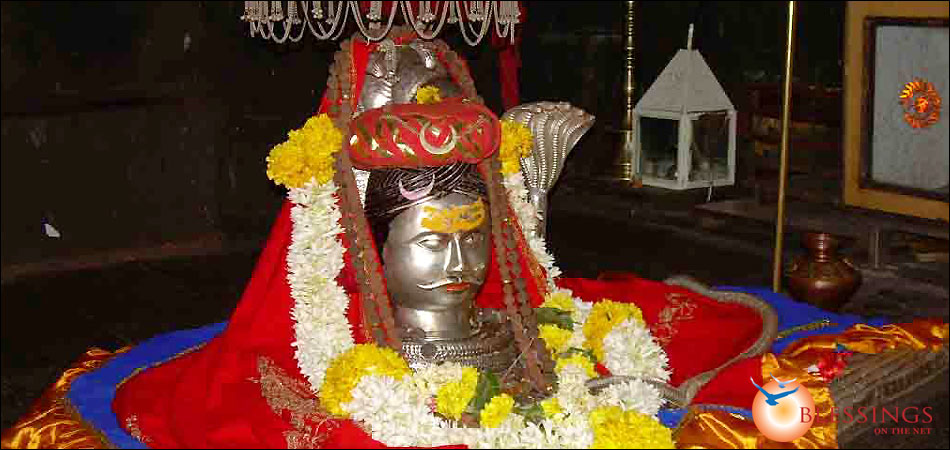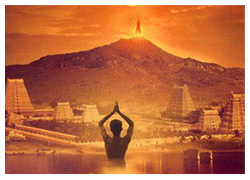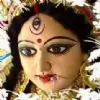Annamaliyar temple, dedicated to lord shiva ,located at the foothills of Annamalai Hills in the town of Thiruvannamali in Tamilnadu .Shiva is worshipped as Annamalaiyar or Arunachaleswarar represented by lingam, with his consort, Unnamulaiyamman (Apithakuchambaal - Parvati). The temple occupies a significant place in Saivam (sect of Shiva) realm and is regarded as one of the Pancha Bootha Stalas (one of the five temples associated with the five classical elements) this temple is associated with the element fire (Agni).
To commemorate this event, every year during the Tamil month of Karthigai in Kiruthigai Star, exactly at 6.00 p.m. Arthanareeswaramurthi presents himself as Jyothi Swaroopa to his devotees at the time of Karthigai Festival 10th day.A divine light of fire is lightened at the top of Annamalai hill to represent it.
[YOUTUBE]http://www.youtube.com/watch?feature=player_detailpage&v=PMV7TAVvVs8[/YOUTUBE]
Saints of Thiruvannamalai.
Thiruvannamalai temple and the hills behind it ,is always associated with numerous divine souls .Where one among them is
Arunagirinathar .
Arunagiri a Tamil poet was born in Thiruvanamalai, during 15 cent A.D. His father died soon after his birth and his mother and sister instilled him with their cultural and religious traditions. Legends claim that Arunagiri was attracted to the pleasures of the flesh and spent his youth in pursuing a life of debauchery. His sister always gave whatever she earned to make her brother happy, and he frequented devadasis. There came a time when his sister had no money to meet his demands. She said that he should sell her in order to have money, upon hearing which Arunagirinathar realised how selfish he had been. He decided to end his life, went to a temple and hit his head against the pillars and steps, begging for forgiveness. Then he leapt from the temple tower.He is saved by LOrd Muruga(skanda),who transformed him, into a saint.Its is said that Lord Skantha asked Arunagiri's life for his(Skantha's) devotion,instead of wasting his soul.
Thus blessed by God Skantha ,he attained the enlightenment and began to sang his first devotional song its collections later called as "Tiruppugazh"(known for its poetical and musical qualities, as well as for its religious, moral and philosophical content in Tamil Literature ) and thereafter decided to spend the rest of his life singing in praise of the God. He was a devotee of Lord Skantha and worshipped him at several places associated with his God Muruga or Skantha.His fame got the jealousy of chief minister named
Sambandandan (who is a great Devi -Upasaka) of king Pravuda deva II ,who ruled the Thiruvannamalai region at that time . He claimed Arunagirinathar as a false saint and not a true devotee of the god Subramaniya(Skantha). So the king arranged a public gathering at Annamalai temple and asked Arunagiri to show(Vision of Lord Skandha ) Subramanya to others also. So Arunagiri started singing songs towards Muruga .But with respect to the evil cheifminister 's wish that he asked Goddess umadevi the previous night ,to hold her son skandha tightly in her hands ,so that Arunagiri will felt ashamed before the crowd, the next morning.Because of this promise Lord skandha was Stopped by DeviParvati,so Skandha ordered Arunagiri to start prising songs on Uma Devi ,Hence fully mesmerized by the beauty of song devi released her child .Thus LOrd Skandha appeared before all the gathering and Blessed them with his vision . The pillar from which Lord Murugan appeared as also the Mandapam where the assembly was convened are to be seen even today in the Arunachaleshwarar Temple, where a small shrine is dedicated to Lord Murugan. As the Lord here came out of a Khamba (pillar), He is called, "Khambattu Ilayanaar."

Statues of Lord Murugan with Arunagirinathar standing on top of the pillar from which the Lord appeared at the Arunachaleswarar Temple
When Arunagirinathar manifested Lord Skanda and the king had Darshana, it is said that the king lost his eye-sight due to the divine brilliance which human sight cannot endure. At once, Arunagirinathar gave Bhasma (vibhuthi/holy ash) and brought back the king's eyesight. This is one version; while the other is that Arunagirinathar fetched the Paarijaatha flowers from heaven and restored the king's vision. It is thus having defeated in the contest, Sambandandan disappeared from the assembly in utter shame and left the kingdom. But his enmity to Arunagirinathar did not subside. He somehow wanted to do away with Arunagirinathar and so, after sometime, he approached the king again. Knowing that the king who had lost his eye-sight would be eager to get it back somehow, Sambandandan said to the king: "O mighty king! There is only one way of getting back your eye-sight. If the heavenly Paarijaatha flowers are brought and placed over your eyes, they will regain vision. And this super-human act, only Arunagirinathar and myself are capable of doing. But I wish that Arunagirinathar do it, as my bringing the flowers will affect his fame and glory. Please, therefore, request Arunagirinathar to fetch the flowers and in case he declines to do so, I shall at once bring them for you."

The Gopura (tower) from which sage Arunagiri as a parrot merged in Lords Skandha's hand.
The king, not knowing Sambandandan's evil intentions but desirous of regaining his vision requested Arunagirinathar accordingly, to which the latter readily agreed. Arunagirinathar climbed the temple gopuram (tower) left his physical body there, entered the body of a parrot that was just dead then, and flew to the heavenly region. It is said that he did this as one cannot go to heaven with this Panchabhuta-Sarira (or body made of five elements). But, strangely, the parrot's body, too, is made up of the same five elements. Sambandandan took this opportunity and informed the king that Arunagirinathar is dead, that his body lies in the Arunachala-Gopuram and that it should be burnt soon. The king, too, without due investigation or thought, ordered it to be cremated, which the evil-minded Sambandandan got done without the least delay, lest Arunagirinathar should come back.The Arunagirinathar-parrot returned from heaven with the Paarijaatha flowers only to find his body missing from the Gopuram. Taking it to be the will of God, the parrot went to the king, offered the flowers to him and, to his great joy, restored the king's eye-sight. The king felt extremely sorry for his hasty and unconsidered action in getting Arunagirinathar's body burnt. He wept bitterly and begged the Saint's pardon. The Arunagirinathar-parrot, his divine mission being over, flew away and seated itself on the arms of the Lord, for eternity.
Ramana Maharishi.
Ramana Maharishi's Birth name is Venkatraman Iyer .He was born to a Tamil-speaking Brahmin family in Thiruchuzhi, Tamil Nadu in 1879 Dec 30.Venkataraman seemed a normal child with no apparent signs of future greatness. He was popular, good at sports, very intelligent but lazy at school, indulged in an average amount of mischief, and showed little religious interest. He did have a few unusual traits. When he slept, he went into such a deep state of unconsciousness that his friends could physically assault his body without waking him up. He also had an extraordinary amount of luck. In team games, whichever side he played for always won. This earned him the nickname 'Tangakai', which means 'golden hand'. When Venkataraman was about 11, his father sent him to live with his paternal uncle Subbaiyar in Madurai for higher Studies.When he was fifteen ,His father Died ,hence he is disturbed by fear of death.He lost his interest in Worldly education and determined to find the truth beyond the birth and death cycles .he preferred to sit alone, absorbed in concentration on the Self, and went daily to the Meenakshi Temple, ecstatically devoted to the images of the Gods, tears flowing profusely from his eyes.

He decided to leave his home and go to Arunachala. Knowing his family would not permit this, he slipped away, telling his brother he needed to attend a special class at school. Fortuitously, his brother asked him to take five rupees and pay his college fees on his way to school. Venkataraman took out an atlas, calculated the cost of his journey, took three rupees and left the remaining two with a note which read: "I have set out in quest of my Father in accordance with his command. This (meaning his person) has only embarked on a virtuous enterprise. Therefore, no one need grieve over this act. And no money need be spent in search of this. Your college fee has not been paid. Herewith rupees two. Thus he reached the Arunachaleswar Temple at Thiruvannamalai and beamed in to a Yogi ,who later worshiped by peoples and still considered as one of the purest soul in near past .He lived at the mountain for the rest of his life. Although born a Bhramin, he declared himself an "Atiasrami", a Sastric state of non-attachment to anything in life and beyond all caste restrictions.The Ashram that grew around him, Sri Ramana Ashram,(Most important for all visitors who seeks his blessings) is situated at the foothill of Arunchala, to the west to the pilgrimage town of Tiruvannamalai.
Story of King Vallala Maharaj :
King Vallala is said to be one among the rulers who is responsible for the construction of temple .During his period he renovated the temple complex ,After completed the construction of the Fourth prakara 's (column)Gopuram ,King Vallala became proud of his achievement. In order to teach him a lesson, Lord Arunachaleswarar refused to leave the temple through the Vallala Gopuram during first 9 days of 10 day Special Festival conducted on that time.The King was distressed and prayed for his forgiveness. Only then, Lord Arunachaleswarar consented to pass through this gopuram on the 10th day of the festival. This is a lesson taught by Lord Siva about humility and greatness, not only to King Ballala but to everyone.
Arunachala Puram describes King Vallala as an embodiment of all human virtues. He was praised for his uprightness, generosity and love for Lord Arunachaleswarar. The King had no issues. Lord Siva tested him for his piety and became a child at the hands of king Vallala and his wife. King Vallala embraced the child in all his lovingness and later Lord Siva disappeared. When the king prayed for a child, Lord Siva assured him that would perform all his funeral rites as he himself became a child to the king. Even now in the month of Maasi (February) when the annual anniversary of King Vallala Deva's death occurs, at the instruction of Lord Arunachaleswarar, the Lord is taken in procession with great Ceremony to the village Pallikonda Pattu, where the funeral rites take place. This festival is known as 'Masi Maga Theerthavari' Urchavam.
Architecture of Annamalai Temple.
The temple at Tiruvannamalai is one of the biggest and grandest temples in South India. With the hill as back ground it gives the appearance of a fort to those who see it from a distance. It is unique on account of its stately towers, high rampart walls, broad quadrangles, spacious gateways, large mantapams and fine tanks. It has also much architectural importance and sculputural beauty.
Tiruvannamalai should have been under the sway of the Pallava Kings who ruled from Kancheepuram before the ninth century A.D. We do not find any inscription in the temple prior to A.D.850 and hence the present temple could not have existed then. Saint Sambandar in his Thevaram relating to this place mentions a temple. Saints Appar and Sambandar belonged to the Seventh Century, Sekkizhar, the renowned author of Periapuranam mentions that both the Saints Appar and Sambandar worshipped Arunchaleswarar in the hill Temple. The Chola Kings ruled over the country for more than four Centuries from 850 A.D. to 1280 A.D. Some earlier Kings of Vijayalaya dynasty must have begun to construct the inner shrine(Garbegraha). In the fourteenth Century the Hoysala Kings had their capital at Tiruvannamalai. Afterwards the Kings of Vijayanagar and Nayak Kings of Thanjavur ruled over this part of the Country. In the Seventeenth Century it came under the sway of the Nawabs of Carnatic. There was confusion and chaos after A.D. 1753. Muraru Raya, Krishna Raya, Mrithis Ali Khan, Burkat Ullakhan, French Soupries and Sambrinet, English Captain Stephen Smith besieged this place and had their successes and defeats. In A.D. 1790 it was captured by Tippu Sultan. During the first half of the nineteenth century it came under the British rule.
The Temple is situated east at the bottom of the hill half a mile west of the Railway Station. It faces East. It has got four stately towers on all the four sides and four high stone walls just like the rampart walls of a fort. The Eastern Tower called the Rajagopuram is the Highest. The Southern tower is called Thirumanjangopuram, that iin the west is called Peygopuram and that in the north is called Ammaniamma Gopuram. The temple occupies an extent of about 25 acres of land. The walls on the East and West measure 700 feet each. The South wall is 1479 feet long and North wall is 1590 feet. The Rajagopuram which adorns the East Gateway is 217 feet high with 11 storeys, its base measure 135 feet by 98 feet. This tower was built by King Krishna Devaraya of Vijayanagar and completed by Sevappa Nayaka of Thanjavur. Krishna Devaraya also constructed the Thousand Pillared Mantapam and dug the tank opposite to it . Ammani Ammal a Sanyasini built the North Gopuram which is called after her name.
The towers, the pillars in the Mantapams and Vimananms consist of figures of Sculptures Excellence. In the side walls of the Entrance of East Gopuram there are dance poses and figures of Bewitching Beauty. Generally stone-Idols are fixed with what is called "Ashtabandana". But in this case it is "Swarnabandana" (Gold) which is of Special Importance. There are five inner rounds. Including what is called Madavilagam running just outside the temple walls and the four car streets and the path round the Giri the temple is said to have Seven Prakaras.
As enjoined, one should enter the temple by the Main Gate in front of the Sanctumsanctorum. Before entering the Eastern Gate we see the Sixteen-Pillared Mantapam and the Four-Pillared Mantapam. When we pass the Eastern Tower Gate we see the Gopura Ganapathi. This deity is held in high esteem and veneration by all devotees and the first worship to Him. We first come to the fifth prakaram and see before us the Kambathilayanar Sannidhi and Gnanappai Mantapam. Here it was that God Muruga appeared in a Pillar for the sake of the King Prabudadevaraya as prayed for by saint Arunagirinathar in response to his famouns song "Athalasadanarada". To the south there is the sacred tank called Sivaganga Theertham. It has stonesteps and Thirumalapathi Mantapam on all four sides.
In the South East corner of this fifth prakaram there is the Adiyar Viduthi (Devotees rest house), Siddhi Vinayagar shrine is found in the North-West side of the tank. To the West of the tank is the Theerthawarimantapam. There is Mangalavinayagar Sannidhi in the fifth South Prakaram and Thiruvarul Vilasa Mantapam just to the West of the South tower. There is the Kothala Vinayagar shrine in the Western Prakaram. There is nothing worth seeing in the Northern Prakaram except the big banyan tree which is considered sacred. Coming again to the Eastern Side of the fifth Prakaram we see the Mathapirappu Mantappam. A festival with Sri Chandrasekara Swami is celebrated here on the first day of the Tamil Month. Then we see the Thousand Pillared Mantapam and the underground temple of Sri Pathala Linga where at Ramana Maharishi's body was eaten by ants and months in his state of Supreme Awareness. In between Sivaganga Tank and Thousand Pillared Mantapam there are the Rudrakshamantapam and the Big Nandhi Mantapam.
The separate temple for Unnamalai Nayaki or Abidhakujambal is situated in the North Western portion of the third Prakaram. In the Mahamantapam in front of the Arthamantapam of this shrine we see the image of Kalanthagar, Veenadharar, Veerabadrar, Adilakshmi, Santhanalakshmi, Gajalakshmi, Dhanalakshmi, Dhanyalakshmi, Vijayalakshmi, Ayswaryalakshmi, Veeralakshmi, Rudra Durga, Mahasakthi and Saraswathi. In the front mantapam there are also the shrines of Vijayaraghava Vinayagar, Navagrahams and Chitraputhrar. To the back of the sanetum-sanctorum we see the Parasakthiamman, Vigneswarar, Cholalingam and Cheralingam. Inside the Garbhagraha we see the charming and graceful Goddess Unnamulai Ambal, the inseperable partner of Sri Anurachaleswara. The Sanskrit name for the Goddess is Abidhakujambal.
After worshipping at Unnamulai Amman's shrine we come to the third Eastern Prakaram. Facing East at the extreme South and Extreme North there are the Shrines of Sambanda Vinayagar and Palaniandavar. On both sides of the entrance to the second Prakaram we see Ganpathi and Subramaniam and the Dwarapalakars (Gate keepers). Taking leave of Adhikara Nandikeswarar in the passage we enter into the second Prakaram. In the North we see Isanyalingam and all Utsavamurthis (festival idols) and in the South there is Indra Lingam. On all there sides of the second Prakaram there are number of deities
.After going round the three sides of the Second Prakaram we enter by the East into the First Prakaram which encloses the Garbagraha of Sri Arunachaleswarar, the main deity of the temple. He has got many names. The popular Tamil Name is Annamalaiyar. Other names are Sonachaleswarar, Arunagiriswarar, Sounadriswarar,Bhaktapasavimochakar,Vedamurthi etc.
Completed ...
My next post will be on Ekambareshwar temple, Kanchipuram.pg 9











































